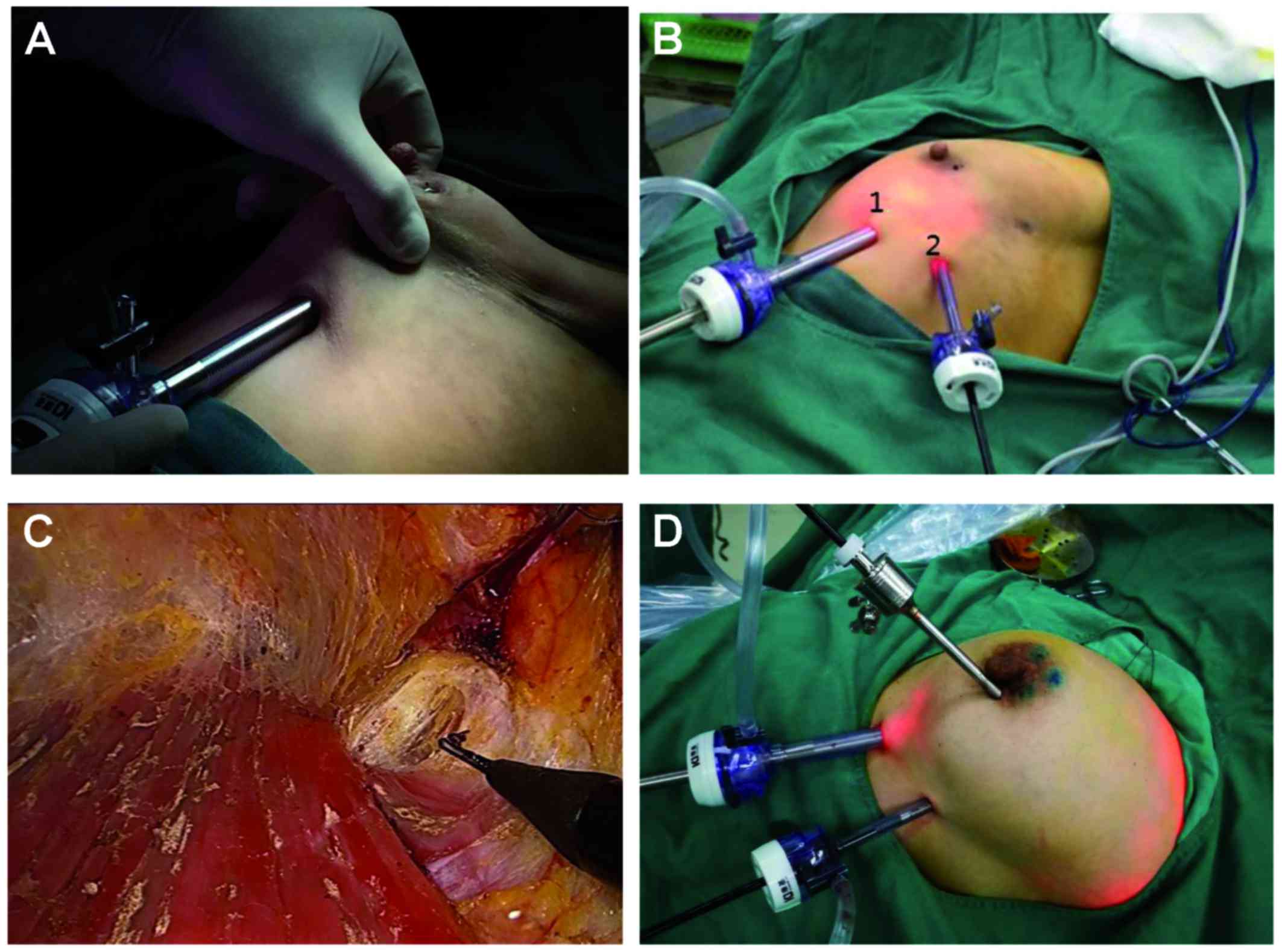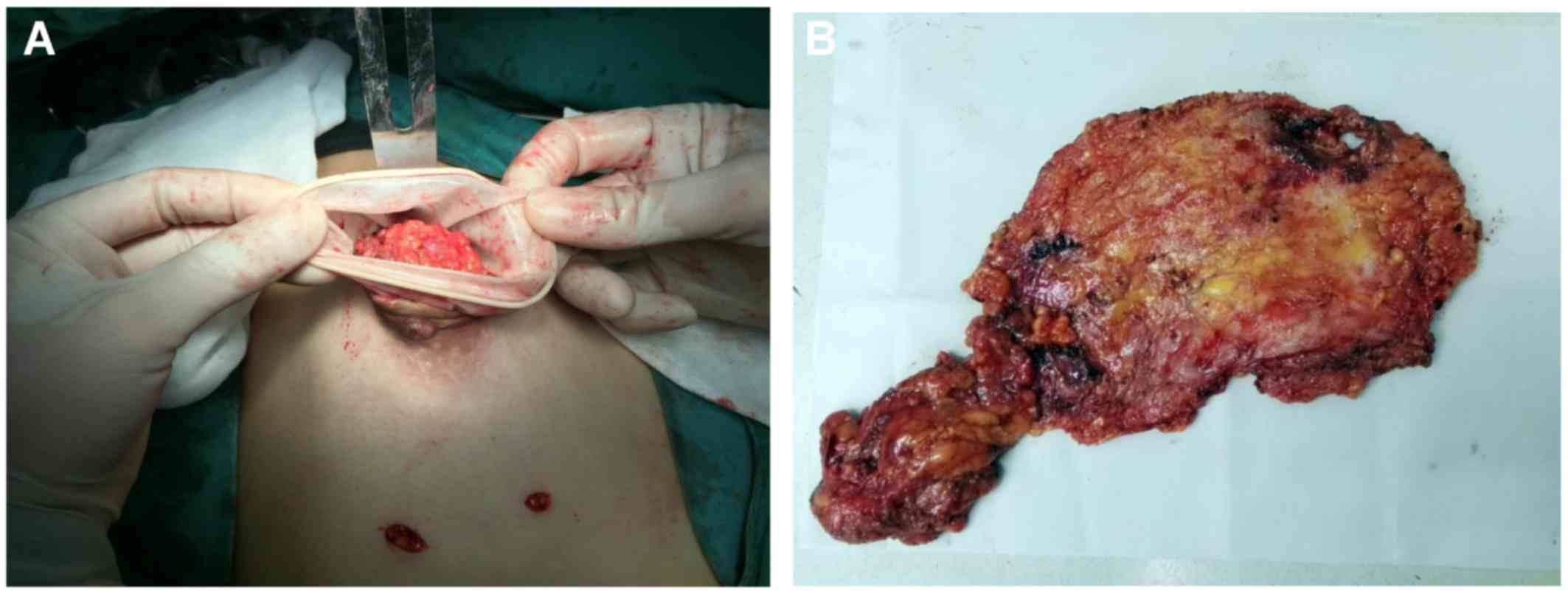|
1
|
Yang W, Sejdinaj F, Shen L, Zhu W, Wang H
and Zhang H: Abstract P2-12-05: Trans-peri-areolar breast
conservative surgery followed by endoscopic axillary lymph node
dissection: A novel surgical option. Cancer Research.
76:P2-12-05–P12-12-05. 2016. View Article : Google Scholar
|
|
2
|
Wang ZH, Qu X, Teng CS, Ge ZC, Zhang HM,
Yuan Z, Gao YG, Lu C, Yu JA and Zhang ZT: Preliminary results for
treatment of early stage breast cancer with endoscopic subcutaneous
mastectomy combined with endoscopic sentinel lymph node biopsy in
China. J Surg Oncol. 113:616–620. 2016. View Article : Google Scholar : PubMed/NCBI
|
|
3
|
Lai H-W, Chen S-T, Chen D-R, Chen SL,
Chang TW, Kuo SJ, Kuo YL and Hung CS: Current Trends in and
Indications for Endoscopy-Assisted Breast Surgery for Breast
Cancer: Results from a Six-Year Study Conducted by the Taiwan
Endoscopic Breast Surgery Cooperative Group. PLoS One.
11:e01503102016. View Article : Google Scholar : PubMed/NCBI
|
|
4
|
Tamaki Y, Tsukamoto F, Miyoshi Y, Tanji Y,
Taguchi T and Noguchi S: Overview: Video-assisted breast surgery.
Biomed Pharmacother. 56 Suppl 1:187s–191s. 2002. View Article : Google Scholar : PubMed/NCBI
|
|
5
|
Keshtgar MR and Fukuma E: Endoscopic
mastectomy: What does the future hold? Wom Health Lond. 5:107–109.
2009. View Article : Google Scholar
|
|
6
|
Ingram D: FRCS DIMBMF: Is it time for
breast cancer surgeons to embrace endoscopic-assisted mastectomy?
ANZ J Surg. 78:837–838. 2008. View Article : Google Scholar : PubMed/NCBI
|
|
7
|
Langer I, Kocher T, Guller U, Torhorst J,
Oertli D, Harder F and Zuber M: Long-term outcomes of breast cancer
patients after endoscopic axillary lymph node dissection: A
prospective analysis of 52 patients. Breast Cancer Res Treat.
90:85–91. 2005. View Article : Google Scholar : PubMed/NCBI
|
|
8
|
Salvat J, Knopf J-F, Ayoubi J-M, Slamani
L, Vincent-Genod A, Guilbert M and Walker D: Endoscopic exploration
and lymph node sampling of the axilla. Preliminary findings of a
randomized pilot study comparing clinical and anatomo-pathologic
results of endoscopic axillary lymph node sampling with traditional
surgical treatment. Eur J Obstet Gynecol Reprod Biol. 70:165–173.
1996. View Article : Google Scholar : PubMed/NCBI
|
|
9
|
Chengyu L, Jian Z, Xiaoxin J, Hua L, Qi Y
and Chen G: Experience of a large series of mastoscopic axillary
lymph node dissection. J Surg Oncol. 98:89–93. 2008. View Article : Google Scholar : PubMed/NCBI
|
|
10
|
Momeni A, Bannasch H, Torio-Padron N,
Borges J and Stark GB: [The application of endoscopy in aesthetic
breast surgery]. Handchirurgie, Mikrochirurgie, plastische
Chirurgie. Organ Deutschsprachigen Arbeitsgemeinschaft
Handchirurgie Organ Deutschsprachigen Arbeitsgemeinschaft Mikrochir
Peripheren Nerven Gefasse. 38:144–148. 2006.
|
|
11
|
Ozaki S, Ohara M, Shigematsu H, Sasada T,
Emi A, Masumoto N, Kadoya T, Murakami S, Kataoka T, Fujii M, et al:
Technical feasibility and cosmetic advantage of hybrid
endoscopy-assisted breast-conserving surgery for breast cancer
patients. J Laparoendosc Adv Surg Tech A. 23:91–99. 2013.
View Article : Google Scholar : PubMed/NCBI
|
|
12
|
Chengyu L, Yongqiao Z, Hua L, Xiaoxin J,
Chen G, Jing L and Jian Z: A standardized surgical technique for
mastoscopic axillary lymph node dissection. Surg Laparosc Endosc
Percutan Tech. 15:153–159. 2005. View Article : Google Scholar : PubMed/NCBI
|
|
13
|
Kamprath S, Bechler J, Kühne-Heid R,
Krause N and Schneider A: Endoscopic axillary lymphadenectomy
without prior liposuction. Development of a technique and initial
experience. Surg Endosc. 13:1226–1229. 1999. View Article : Google Scholar : PubMed/NCBI
|
|
14
|
Lai HW, Wu HS, Chuang KL, Chen DR, Chang
TW, Kuo SJ, Chen ST and Kuo YL: Endoscopy-Assisted Total Mastectomy
Followed by Immediate Pedicled Transverse Rectus Abdominis
Musculocutaneous (TRAM) Flap Reconstruction: Preliminary Results of
48 Patients. Surg Innov. 22:382–389. 2015. View Article : Google Scholar : PubMed/NCBI
|
|
15
|
Cangiotti L, Poiatti R, Taglietti L, Re P
and Carrara B: A mini-invasive technique for axillary
lymphadenectomy in early breast cancer: a study of 15 patients.
Journal of experimental & clinical cancer research: CR.
18:295–298. 1999.
|
|
16
|
Ho WS, Ying SY and Chan AC:
Endoscopic-assisted subcutaneous mastectomy and axillary dissection
with immediate mammary prosthesis reconstruction for early breast
cancer. Surg Endosc. 16:302–306. 2002. View Article : Google Scholar : PubMed/NCBI
|
|
17
|
Brun JL, Rousseau E, Belleannée G, de
Mascarel A and Brun G: Axillary lymphadenectomy prepared by fat and
lymph node suction in breast cancer. Eur J Surg Oncol. 24:17–20.
1998.(EJSO). View Article : Google Scholar : PubMed/NCBI
|
|
18
|
Kühn T, Santjohanser C, Koretz K, Böhm W
and Kreienberg R: Axilloscopy and endoscopic sentinel node
detection in breast cancer patients. Surg Endosc. 14:573–577. 2000.
View Article : Google Scholar : PubMed/NCBI
|
|
19
|
Malur S, Bechler J and Schneider A:
Endoscopic axillary lymphadenectomy without prior liposuction in
100 patients with invasive breast cancer. Surg Laparosc Endosc
Percutan Tech. 11:38–41; discussion 42. 2001. View Article : Google Scholar : PubMed/NCBI
|
|
20
|
Leff DR, Vashisht R, Yongue G, Keshtgar M,
Yang GZ and Darzi A: Endoscopic breast surgery: Where are we now
and what might the future hold for video-assisted breast surgery?
Breast Cancer Res Treat. 125:607–625. 2011. View Article : Google Scholar : PubMed/NCBI
|
|
21
|
Ozaki S and Ohara M: Endoscopy-assisted
breast-conserving surgery for breast cancer patients. Gland Surg.
3:94–108. 2014.PubMed/NCBI
|













